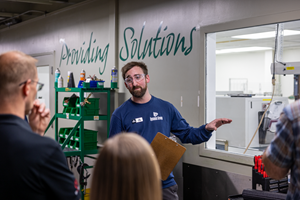EconCore Expands Continuous Production of Thermoplastic Honeycombs for Composites
ThermHex technology has been used successfully to produce honeycombs from several high-performance thermoplastics.
ThermHex technology has been used successfully to produce honeycombs from several high-performance thermoplastics.
Belgium’s EconCore is extending the capabilities of its innovative ThermHex technology for the production of high-performance lightweight thermoplastic honeycomb core materials and sandwich panels. Already a licensor of the technology for production of PP honeycombs, the company says it can now produce honeycombs from high-performance thermoplastics (HPT).
According to EconCore COO Tomasz Czarnecki, the company has successfully produced and tested honeycomb structures made with modified PC, nylon 66, and PPS, and are continuing to pursue development with these and other high-end polymers. “We are now entering the final phase of product validation and we expect to work on several application developments in automotive, aerospace, transportation, and building and construction markets this year.”
The patented ThemHex technology uses a series of in-line, high-speed operations to produce honeycomb structures from a single continuously extruded thermoplastic film. It involves a sequence of thermoforming, folding and bonding operations. The technology has the potential to work with a wide range of thermoplastics to create honeycombs whose cell size, density and thickness can be altered with simple hardware and/or process parameter adjustments. The process makes it possible to create extremely cost-effective finished composite sandwich materials by inline bonding of skins to the honeycomb.
Thermoplastic honeycomb cores for composites provide a performance-to-weight ratio that is very difficult to achieve with other types of core materials. ThermHex cores are reportedly about 80 percent lighter than solid thermoplastic cores in use currently in products such as metal-skinned panels for transportation and building applications. The lightweight cores also have positive implications for product handling, raw material inventory, outbound logistics and installation. In addition to their superior mechanical performance, honeycomb structures are also touted for their acoustic performance and thermal insulation in many applications.
HPT honeycombs, according to EconCore, will build on the intrinsic benefits of lightweight honeycomb structures, with higher heat resistance (useful for products such as housings for electric vehicle batteries) and very good flame resistance (critical for building panels).
EconCore is also working with materials modified for FST (flame, smoke, toxicity) compliance in railway and aerospace. The company also sees significant potential in photovoltaic (PV) panes and numerous other products. The company has already demonstrated the potential for the use of PC honeycombs in next-generation aircraft interior modules—developed in an EU-sponsored project with aerospace company Diehl Aircabin. Nylon 66 honeycomb technology has also been demonstrated in ultralight PV panels co-developed with panel maker Armageddon Energy and DuPont.
Meanwhile, EconCore is also developing a variant of the ThermHex technology for production of what it calls Organosandwich materials. These are thermoplastic sandwich composite materials, again produced inline, which comprise a thermoplastic honeycomb core thermally bonded between thermoplastic composite skins reinforced with continuous glass fibers. In contrast to conventional organosheets, an Organosandwich reportedly offers outstanding stiffness-to-weight ratio and can be converted into final parts using such quick and efficient processes as compression molding and injection molding.
Compared to more conventional composite and metal-based solutions, EconCore says these products offer superior lighweighting potential and important cost benefits combined with extremely fast processing for the creation of complex functionalized parts. The Organosandwich materials are said to be ideal for applications requiring light and cost-effective materials combined with high stiffness, such as structural automotive components and markets with similar requirements.
Related Content
Medical Molder, Moldmaker Embraces Continuous Improvement
True to the adjective in its name, Dynamic Group has been characterized by constant change, activity and progress over its nearly five decades as a medical molder and moldmaker.
Read MoreBMW Group Vehicle to Adopt 3D Printed Center Console
A vehicle coming to market in 2027 will include a center console carrier manufactured through polymer robot-based large-format additive manufacturing (LFAM).
Read MoreHow to Optimize Injection Molding of PHA and PHA/PLA Blends
Here are processing guidelines aimed at both getting the PHA resin into the process without degrading it, and reducing residence time at melt temperatures.
Read MoreMultilayer Solutions to Challenges in Blow Molding with PCR
For extrusion blow molders, challenges of price and availability of postconsumer recycled resins can be addressed with a variety of multilayer technologies, which also offer solutions to issues with color, processability, mechanical properties and chemical migration in PCR materials.
Read MoreRead Next
Lead the Conversation, Change the Conversation
Coverage of single-use plastics can be both misleading and demoralizing. Here are 10 tips for changing the perception of the plastics industry at your company and in your community.
Read MoreSee Recyclers Close the Loop on Trade Show Production Scrap at NPE2024
A collaboration between show organizer PLASTICS, recycler CPR and size reduction experts WEIMA and Conair recovered and recycled all production scrap at NPE2024.
Read More














